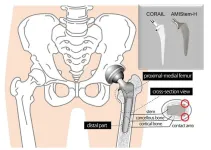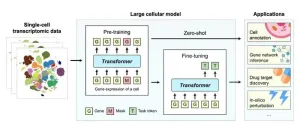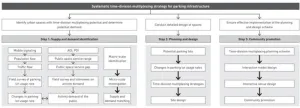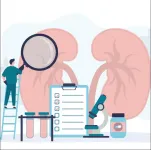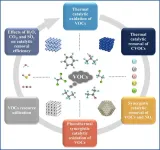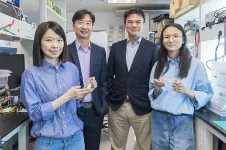(Press-News.org) Commercial arm robots are increasingly deployed in order to aid stroke patients in their recovery. Around 80% of patients have problems with their arm function. Robots are also seen as a solution for financial, and staffing, shortcomings in the healthcare sector. However, research led by Amsterdam UMC now shows that they offer no clinically meaningful effects for patients. The research is published today in Neurology.
"In particular countries such as China, Japan and South Korea, but also in North America and Europe, are UL-Robots seen more and more as the solution for lack of intensive upper limb training. But our research shows that they really need to be rethought if they are ever to meaningfully contribute to care package that we can offer,” says Gert Kwakkel, Professor of Neurorehabilitation at Amsterdam UMC and the leader of the study that started in May 2020.
The researchers analyzed 90 studies using data from more than 4,000 patients who rehabilitated after a stroke with or without the help of arm robots. The results of the study show that, despite a small improvement of about 3% in muscle and arm function, this does not result in an improvement in arm-hand dexterity. Furthermore, it appears that the healthcare costs are only higher with the purchase of a robot than with regular treatment with a physiotherapist or occupational therapist.
"Our findings provide robust evidence. This evidence is independent of the type of robot used, the number of weights the robot checks, the cost, and additional features – such as virtual game displays – that have been added to the robot arm. With the data of more than 4,000 patients and thousands of treatments, we would have been able to demonstrate the presence of a positive effect of the arm robots. The fact that this did not happen suggests that the arm robots are more of a hype than an actual solution," says Kwakkel, who is also head of research at Amsterdam Rehabilitation Centre Reade.
"We saw that arm robots have evolved tremendously over time, but that despite improvements in technology, they have not delivered any improvement for patients over the past two decades. Despite the fact that the robots are being used more and more, the evidence is still lacking. Robots that can completely take over arm and hand function, by using an interface that is directly or indirectly controlled from the brain, seem to be more promising when it comes to regaining important functions such as grasping and reaching. However, this development is still in its infancy. For the time being, future research in the field of rehabilitation robotics will have to focus more on better understanding how stroke patients learn to regain their skills," concludes Kwakkel.
END
Arm robots are not the answer for stroke rehabilitation
Research led by Amsterdam UMC shows that, among 4000 patients, robots do not show clinical relevance in arm recovery
2024-07-23
ELSE PRESS RELEASES FROM THIS DATE:
Staying hip to orthopedic advances: Comparing traditional and new hip replacement stems
2024-07-23
Osaka, Japan — Needing a hip replacement is unfortunate, but even more unfortunate is to need to do it again.
Surgeons at Osaka Metropolitan University have provided new insights into the performance of two types of stems used in total hip replacement surgery. Their findings are expected to contribute to the enhancement of long-term outcomes, improving patients’ quality of life and reducing the need for revision surgeries.
Their paper was published in The Bone & Joint Journal on June 1.
The hip joint, which connects the femur, or thighbone, to the pelvis, plays a crucial ...
Brain care score for dementia and stroke also predicts late-life depression
2024-07-23
Late-life depression, typically defined as depression with onset in individuals over 60 years of age, can affect up to a third or more of people older than 60 and can be debilitating. But, like other neurological conditions, an individual’s risk may be influenced by lifestyle choices. Researchers from Mass General Brigham previously developed and validated the Brain Care Score (BCS) for helping patients and clinicians identify lifestyle changes that may reduce their risk of dementia and stroke. Now, with collaborators at Yale University, they have shown that a higher BCS is also associated with a ...
A window of opportunity for climate change and biodiversity
2024-07-23
World leaders must take advantage of a pivotal window of opportunity for forging a much-needed joined-up approach to tackle climate change and biodiversity loss, say scientists from ZSL and York University. Without this, work on tackling either crisis could inadvertently harm progress on the other.
Published today (Tuesday 23 July) in the Journal of Applied Ecology, a paper from international conservation charity ZSL and researchers at York University, Toronto, titled ‘The Kunming-Montreal Global Biodiversity Framework and the Paris Agreement need a joint work programme for climate, nature, and people’ conceptualises how a joint work ...
Quantitative Biology journal features groundbreaking perspectives on large cellular models
2024-07-23
In a landmark move to advance the frontiers of artificial intelligence, the Quantitative Biology (QB) journal has published a comprehensive commentary titled "Current Opinions on Large Cellular Models," highlighting the cutting-edge developments in the field of large cellular models (LCMs). The journal has brought together a consortium of leading scholars from China, the United States, and Canada to delve into the future of AI-driven biological research.
The commentary features influential authors behind some of the most impactful LCMs, such as scBERT, Geneformer, scGPT, scFoundation, and GeneCompass. These AI ...
Time-division multiplexing planning and design strategies for parking lots in compact cities
2024-07-23
Compact city is an urban planning strategy aimed at promoting environmental, economic, and social sustainability through spatial configurations featured with relatively high density and mixed land use. The continuous growth in car ownership forces cities to construct more static transportation facilities such as parking lots, squeezing the activity spaces of residents and consequently giving rise to a series of efficiency and equity issues. Thus, the conflict between people and vehicles in compact cities is increasingly prominent and urgently ...
New imaging technique reveals intracellular energy dynamics in kidney cells
2024-07-23
The prevalence of kidney disease has been increasing in Japan, with it now affecting one in eight adults, but developing effective treatment remains a challenge. The kidneys are among the most energy-intensive organs in the body. For the kidneys to function, they constantly produce and consume large amounts of adenosine triphosphate (ATP), which is a chemical that the body uses to store and transport energy. However, ATP dynamics—the changes over time in ATP production and utilization—within the kidney have been poorly understood because of the lack of suitable imaging technologies.
Using a newly developed ATP imaging system, the researchers ...
Could smart guide RNAs usher in an era of personalized medicine?
2024-07-23
Guides typically assist tourists with directions, but the experience could be greatly enhanced if they offered personalized services tailored to individual interests. Recently, researchers have transformed guide RNAs, which direct enzymes, into a smart RNA capable of controlling networks in response to various signals. This innovative research is gaining significant attention in the academic community.
A research team consisting of Professor Jongmin Kim and PhD candidates Hansol Kang and Dongwon Park from the Department of Life Sciences at POSTECH has developed a multi-signal ...
Recent progress on VOC pollution control via the catalytic method
2024-07-23
Volatile organic compounds (VOCs), with toxicity and irritability, could cause atmospheric environmental problems such as haze and photochemical smog, seriously threatening the ecological environment and human health. The primary source of VOCs is human production, such as the petrochemical industry, pharmaceutical industry, footwear industry, electronic manufacturing, and cooking fumes. Catalytic oxidation technology can highly effectively remove organic pollutants without secondary pollution, and it is receiving increasing attention in VOC pollution control. In real-world operating conditions, the ...
Stabilizing perovskite solar cells in hot and humid conditions
2024-07-23
HONG KONG (21 July 2024) --- The progress of solar energy technology took a step forward recently with the development of a groundbreaking living passivator at City University of Hong Kong (CityUHK) that can substantially enhance the stability and efficiency of perovskite solar cells.
This newly developed passivator is a type of corrosion inhibitor that appreciably changes the potential of a metal. The CityUHK technology leverages dynamic covalent bonds that activate on exposure to moisture and heat, enabling it to evolve new passivators in response to environmental factors.
This innovative approach allows for real-time repair and maintenance of perovskite solar cells. ...
Trajectory of type 1 diabetes risk shifts after age 10 years between at-risk males and females
2024-07-23
New research presented at this year’s Annual Meeting of the European Association for Study of Diabetes (Madrid, Spain, 9-13 September) shows that the risk of developing type 1 diabetes (T1D) decreases markedly in girls after age 10 years, while the risk in boys stays the same.
Furthermore, risk of T1D is significantly higher boys with a single autoantibody than their female counterparts, suggesting the sex could be linked with autoantibody development, indicating the importance of incorporating sex in the assessment ...
LAST 30 PRESS RELEASES:
Why nail-biting, procrastination and other self-sabotaging behaviors are rooted in survival instincts
Regional variations in mechanical properties of porcine leptomeninges
Artificial empathy in therapy and healthcare: advancements in interpersonal interaction technologies
Why some brains switch gears more efficiently than others
UVA’s Jundong Li wins ICDM’S 2025 Tao Li Award for data mining, machine learning
UVA’s low-power, high-performance computer power player Mircea Stan earns National Academy of Inventors fellowship
Not playing by the rules: USU researcher explores filamentous algae dynamics in rivers
Do our body clocks influence our risk of dementia?
Anthropologists offer new evidence of bipedalism in long-debated fossil discovery
Safer receipt paper from wood
Dosage-sensitive genes suggest no whole-genome duplications in ancestral angiosperm
First ancient human herpesvirus genomes document their deep history with humans
Why Some Bacteria Survive Antibiotics and How to Stop Them - New study reveals that bacteria can survive antibiotic treatment through two fundamentally different “shutdown modes”
UCLA study links scar healing to dangerous placenta condition
CHANGE-seq-BE finds off-target changes in the genome from base editors
The Journal of Nuclear Medicine Ahead-of-Print Tip Sheet: January 2, 2026
Delayed or absent first dose of measles, mumps, and rubella vaccination
Trends in US preterm birth rates by household income and race and ethnicity
Study identifies potential biomarker linked to progression and brain inflammation in multiple sclerosis
Many mothers in Norway do not show up for postnatal check-ups
Researchers want to find out why quick clay is so unstable
Superradiant spins show teamwork at the quantum scale
Cleveland Clinic Research links tumor bacteria to immunotherapy resistance in head and neck cancer
First Editorial of 2026: Resisting AI slop
Joint ground- and space-based observations reveal Saturn-mass rogue planet
Inheritable genetic variant offers protection against blood cancer risk and progression
Pigs settled Pacific islands alongside early human voyagers
A Coral reef’s daily pulse reshapes microbes in surrounding waters
EAST Tokamak experiments exceed plasma density limit, offering new approach to fusion ignition
Groundbreaking discovery reveals Africa’s oldest cremation pyre and complex ritual practices
[Press-News.org] Arm robots are not the answer for stroke rehabilitationResearch led by Amsterdam UMC shows that, among 4000 patients, robots do not show clinical relevance in arm recovery
